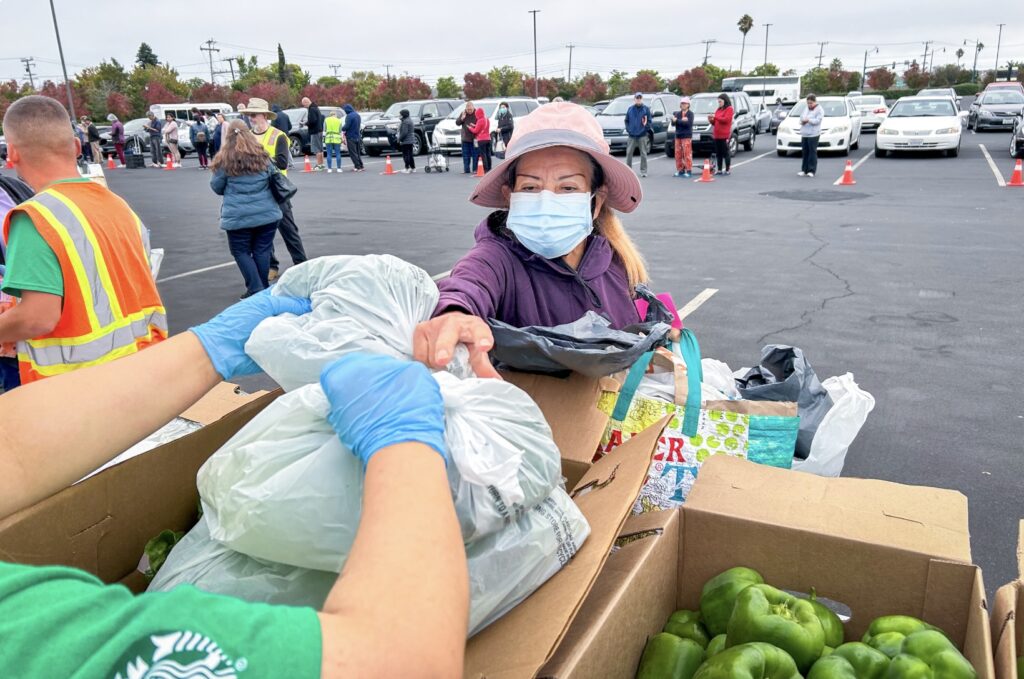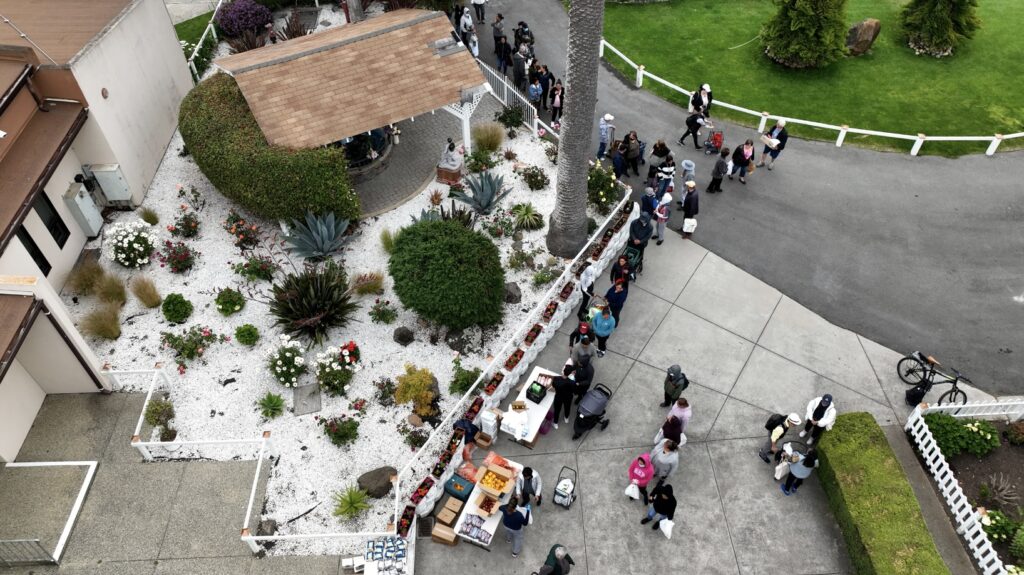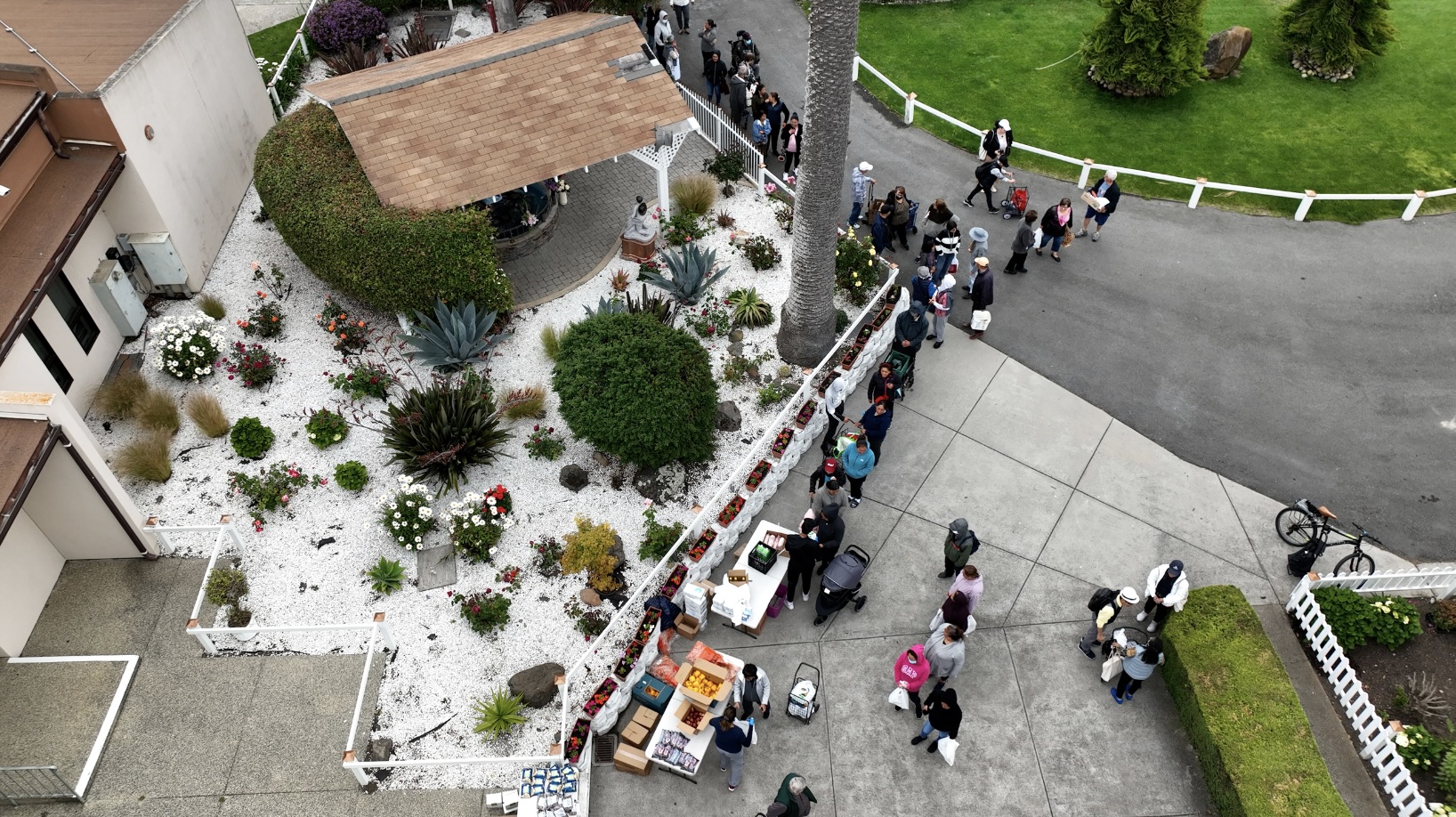|
Getting your Trinity Audio player ready...
|
PRESS RELEASE. From the San Mateo County Executive Office on October 9th, 2024.
San Mateo – At 8:30 on a gray Thursday morning, Ines Flores, age 75 and towing a blue wagon, arrived at the front of a snaking line she joined more than an hour ago.

“Five families,” she said. “Please.”
Volunteers quickly loaded her wagon and filled her shopping bags with cartons of milk, dozens of eggs, lettuce, carrots, bell peppers, apples, watermelons, beans. Later she would share everything with families from her church who were busy working.
“The problem is there are so many poor people,” the Daly City resident said. “Life is so expensive. How are they going to pay the rent and buy food?”
That’s a question faced by thousands of individuals and families across San Mateo County.
By most measures, San Mateo is one of the wealthiest counties in the United States with the nation’s fifth highest median household income. Yet numbers can mask a reality that plays out daily at food distribution sites and pantries from Daly City to East Palo Alto to Pescadero.

Flores was among more than 400 people who went home with groceries from the San Mateo County Event Center. Volunteers in reflective vests directed traffic in a South San Francisco parking lot to keep cars from backing up onto streets. The families of farmworkers line up in downtown Half Moon Bay to receive boxes of fruits and vegetables they grow but can’t afford to buy.
And at Cañada College, Jacob Kapisi, an 80-year-old retired machinery operator, waited under a searing fall sun for his turn to bring home peppers, lettuce, frozen blueberries and more. On paper, Kapisi and his wife are doing fine: they bought a three-bedroom home for $110,000 years ago in a Redwood City neighborhood where similar homes now go for $1.2 million. Yet his pension and other income have not kept up with the price of, well, everything.
“The cost of food, the water bill, medication…,” said Kapisi, who pays hundreds of dollars each month for diabetes medication. “Everything now is so high.”
To help struggling residents put food on the table, the Board of Supervisors in August 2024 granted Second Harvest of Silicon Valley $2 million to provide 4 million nutritious meals over the next year. The food bank works with an extensive network of partners – local pantries, faith-based organizations, schools, soup kitchens, senior centers – and community of volunteers to feed an average of 129,000 people a month in San Mateo County.
“Inflation has been very, very hard on our communities,” said Tracy Weatherby, Second Harvest’s vice president of strategy and advocacy. “What we are seeing now in terms of need is every bit as big as it was during the pandemic.”
The price of groceries shot up 30 percent since January 2020 in the San Francisco-Oakland-Hayward region, which includes San Mateo County, according to the U.S. Bureau of Labor Statistics. Fuel and utility costs rose 48 percent regionally during the same period; the cost of motor-vehicle insurance climbed 51 percent nationally in the past three years.
The cost of living is so high the federal government considers a family of four earning $156,650 a year “low income.” A three-person household earning as much as $201,500 annually is listed as “moderate income.”
What numbers fail to capture is the ever-present stress. Many people interviewed for this article said they worried about simply being able to pay their bills, let alone afford luxuries or a nice vacation.
A recent client survey by Second Harvest of Silicon Valley found that nearly 60 percent of respondents have less than $100 in savings. Nearly 65 percent are worried about their ability to pay their rent or mortgage next month, and more than 55 percent do not believe their financial situation will get better in the next year.
“My husband (a car mechanic) doesn’t have much salary,” said a 60-year-old San Mateo woman who asked to remain anonymous.
She ran her own custom food business before the pandemic. But sales to restaurants – her primary customers – have never rebounded. Food banks now help stretch her budget. “Meat. Milk. Butter. All the milk products are getting so expensive,” she said. “The cost of groceries is getting higher every month.”

At Ayudando Latinos A Soñar, a nonprofit based in Half Moon Bay, a team of 60 volunteers arrives at 6 a.m. to their bright yellow headquarters every two weeks to set up for the 10 a.m. free pantry.
“It’s a program that grew out of need during the pandemic,” said Sandra Sencion, director of the farmworker program at ALAS who grew up in Half Moon Bay. “We thought it was going to be a temporary program. We started with five, 10, 15 families.
“Unfortunately, our community here in Half Moon Bay was faced with crisis after crisis. The forest fires on top of the pandemic. We had the flooding. We had the tragic mass shooting last year. We realized the need was not going to go away…. Our numbers went from 15 during COVID to 400 families,” Sencion, 28, said. “Several of the community members that we feed are farmworkers. There’s irony there.”
Across San Mateo County, the number of households relying on CalFresh has risen 40 percent since 2020 (15,115 to 21,274), according to the CalFresh dashboard. CalFresh is a federal nutrition program that lets eligible households buy food with a preloaded debit card.
The monthly CalFresh allotment, however, is often insufficient. Recipients often rely on supplemental assistance from food banks: the maximum monthly CalFresh allotment for one person is $292.
No one needs to show documents to receive groceries from Second Harvest or its partner network. This helps families that may not qualify for CalFresh or other safety-net programs, may be going through a temporary rough patch or may feel a sense of stigma that prevents them from applying for aid.
San Bruno resident Evelin Amarilis Contreras Herrera, 42, was among the volunteers handing out low-fat milk, cage-free eggs, bags of dried beans, potatoes, squash and much more at one of three distributions run by the YMCA Community Resource Center in South San Francisco.
Contreras Herrera and her husband, a gardener and day laborer by trade, have a 13-year-old girl and twin 10-year-old boys. With food costs spiraling, hungry kids and friends barely making ends meet, at the end of her shift she will take home food for hers and five other families – about 30 people in all.
She has a passion for cutting up and bagging melons and other fruits to give to older neighbors and friends “so everyone can get a little,” she said in Spanish translated by the YMCA’s Elida Sobalvarro Valencia. “In my case I have friends because I feed them, Contreras Herrera said with a laugh. “I share.”
This particular YMCA grocery program serves about 350 households twice a month. Sobalvarro Valencia, the 27-year-old director of the Community Resource Center and a South San Francisco High graduate, sees the need daily in her community.
“It saddens me and makes me a little frustrated to know that there’s so much need folks are willing to wait in long lines for their portion of food, though I’m glad there are resources to help in some way,” she said.
The people who show up at food banks and pantries are just a share of those who need assistance. Surveys conducted by Second Harvest “tell us that most people are reluctant to get food assistance even when they need it” because “they fear the social stigma and judgment of asking for support.”
Fletcher Stanford is what’s known in military terms as a force multiplier. The 64-year-old retired MUNI driver with a ready smile jokes he is accustomed to getting up early and driving routes.
So there he was on a Tuesday morning in Lot 6 at Cañada College loading sacks of onions and potatoes, boxes of fruits and vegetables, cases of pasta sauce and crates of juice onto and into his blue Honda Ridgeline pickup. He delivered the groceries to 15 families at a San Mateo apartment complex.
Stanford collects food at distribution sites across the county each week. (He’s well known: at Cañada on a Tuesday, at the Event Center on a Thursday, someone yelled out, “Fletcher is here!”)
A volunteer, he delivers to seniors, a woman who had a recent surgery, working families, pretty much anyone in need within his word-of-mouth network. Sure, he said, median household income is high and the unemployment rate low.
“Everybody makes good money but people pay a lot of money for housing and rent to live in a good, safe neighborhood,” he said. “Then you have to buy clothes, have money for a laptop for the kids….. It’s never ending.”
Then he was off to make another delivery.

2024 Election


The 2024 Board of Supervisors, from left: Ray Mueller (D3), Noelia Corzo (D2), Warren Slocum (D4, BOS President), David J. Canepa (D5, BOS Vice President) and Dave Pine (D1, outgoing BOS President).





